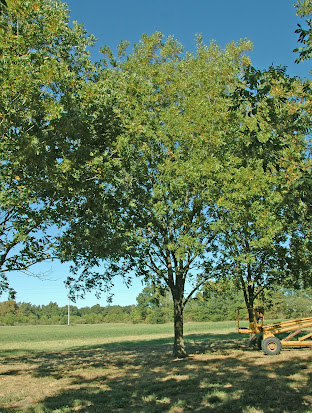The other day I was scouting my orchard for pecan shuck split when I noticed a dramatic difference in nut size and ripening between a young grafted Caney tree and the mature mother Caney tree located in my pecan breeding block.
Let's look at the trees in question. The photo at right is a young Caney tree. This tree has a good crop of nuts and the nuts are only slightly smaller than normal. The important thing to notice in this photo is how much open space there is around the tree. In a year of short water supply this Caney tree has very little competition from other trees for water.
The photo at left shows the original Caney tree growing in my pecan breeding block. This tree is much larger (28 yrs. old) and is crowded by other large trees (note the shade on the ground). Note the yellowing of some of this tree's leaves. This is an indication of extreme water stress caused by the competition for water from neighboring large trees. Although there is a good crop of nuts on the tree, the nuts are tiny.
The photo above illustrates the differences I observed in the nuts produced by the young, well-spaced Caney tree and the mature, crowded Caney tree. First there is the obvious size difference. But secondly, note that the nuts produced by the young tree have split shuck while shucks are still firmly attached over the nuts collected from the mature tree. This simple observation leads me to a very important decision; After harvest, I need thin out more trees in the pecan breeding block.
Caney is one of the scab-resistant cultivars I developed from my pecan breeding project. The photo above gives you a good idea of what Caney nuts look like. Over the years, Caney has produced nuts that are larger than Kanza with nearly 53% kernel. Caney matures a week before Kanza. This cultivar has a protandrous flowering habit making it a good pollen pairing for Kanza. Kernels are straw-colored and have excellent quality.



